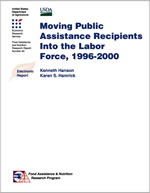Moving Public Assistance Recipients Into the Labor Force, 1996-2000
- by Kenneth Hanson and Karen Hamrick
- 5/11/2004
Overview
Moving recipients of public assistance into jobs is a goal of the current system for providing public assistance to low-income households. Using scenario analysis with a computable general equilibrium model, ERS researchers examined some of the labor market impacts of the "welfare-to-work" provisions of the Personal Responsibility and Work Opportunity Reconciliation Act of 1996 (PRWORA). The results show that, from 1996 to 2000, the influx of public assistance recipients into the labor force put downward wage pressure on low-skill occupations, making wage growth smaller than it would have been without the influx. At the same time, the influx added workers to the labor force, which contributed to economic growth. By expanding the labor force, the influx contributed 1 percentage point of real economic growth in terms of gross domestic product from 1996 through 2000.
Download
-
Entire report
Download PDF -
Abstract, Acknowledgments, Contents, Summary, Introduction
Download PDF -
From Public Assistance to Work
Download PDF -
Methodology
Download PDF -
Scenarios and Results
Download PDF -
Conclusions
Download PDF -
References
Download PDF -
Appendix A
Download PDF -
Report summary
Download PDF

